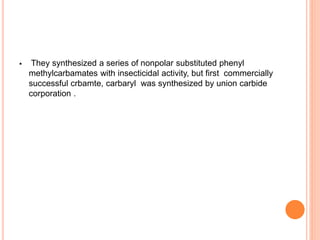CARBAMATE INSECTICIDESS.pptx
- 1. CARBAMATE INSECTICIDESS The carbamate insecticides exits as esters of carbamic acid, typically have some kinds of aryl substituent as the leaving group. These compound are mot soluble in organic solvents. other carbamates are more aliphatic in nature and may posses sufficient miscibility with water to act as effective plant systemic insectiides. O R1 OCN R3 R2
- 2. DEVELOPMENT OF CRBAMATE INSECTICIDES In the 17th century the natives of the old calabar region of southeast Nigeria, the Effiks, used the coffee-coloured beans, physostigma venenosum in witchcrafts . The crushed bean called ‘esere’ was used as a poison ordeal to establish the guilt of a poisoner Later the alkaloid was isolated , purified and renamed physostigmine. During the same time miotic and cholingeric properties of physostigmine were discovered. The molecular structure was established in 1925 and the compound was synthesized in 1945.
- 3. Stedman elucidated the structure of physostigmine and also synthesized a number of synthetic analogues of methylcarbamates some of which were toxic to many insect species. Aeschlimann and Reinert synthesized the corresponding active and stable dimethylcarbamate which is nestigmine. Hans Gysin and co-workers discovered the insecticidal properties of N-dimethylcaramates in the late 1940s and synthesized a number of analouges including dimetan , dimetilan , isolan, pyramat, pyrolan etc.
- 4. These compounds though were highly toxic to aphids and house flies possessed only limited toxicity towards others insects and due to narrow spectrum of toxicity could not be introduced commercially. At about the same time Metcalf and co-workers modified the structure of simple phenylmethyl carbamates to increase their lipid solubility They discovered that substation in the ortho or meta position with alkyl group or a halogen in a phenyl methylcarbamate increased its insecticidal activity.
- 5. They suggested three major requirements for optimum contact insectidal activity of a carbamate molecule: 1. It should be nonpolar, to be able to penetrate to the site of action in the insect nerve, 2. It should be structurally complementary to the active surface of cholinesterase, both in stereochemistry and reactivity, to effectively inhibit the enzyme; and 3. It should possess sufficient stability to multifunction-oxidase detoxication
- 6. They synthesized a series of nonpolar substituted phenyl methylcarbamates with insecticidal activity, but first commercially successful crbamte, carbaryl was synthesized by union carbide corporation .
- 7. In the early 1960s it was found that carbamoyl oximes of cyclic ketones possessed, in addition to insecticidal properties, acaricidal and nematicidal properties. This led to the synthesis of trisubstituted acetaldehyde O-oximes which was structurally similar to acetylcholine. Aldicarb, an open-chain carbomoyloxime, was subsequently synthesized.
- 8. MODE OF ACTION Carbamate insecticides, like the organophosphorus compound, inhabits acetyl cholinesterase by acting as a substrate for enzyme, resulting in the accumulation of acetylcholine in the nerve synapse and causing a disruption of nerve function. When a carbamate insecticide enters the synapse, it completes with acetylcholine for the active site on the enzyme. The insecticide binds to the enzyme and forms a complex The enzyme which is inhibited by OP insecticides is considerably less susceptible to hydrolysis as a result regeneration of the free enzyme is slow and recovery from OP poisoning is a much slower process.
- 9. The carbamates react with series hydroxyl group within the enzymes active site, resulting in carbamylation of this hydroxyl and group and yielding a hydroxylated “leaving group”. This group inactivates the enzyme and blocks the degeneration of the neurotransmitter acetylcholine.
- 10. IN INSECTS Hyperactivity Incorodinated movements Convulsions Erratic tremors
- 11. ANTIDOTE Atropine antagonizes activity of acetylcholine










